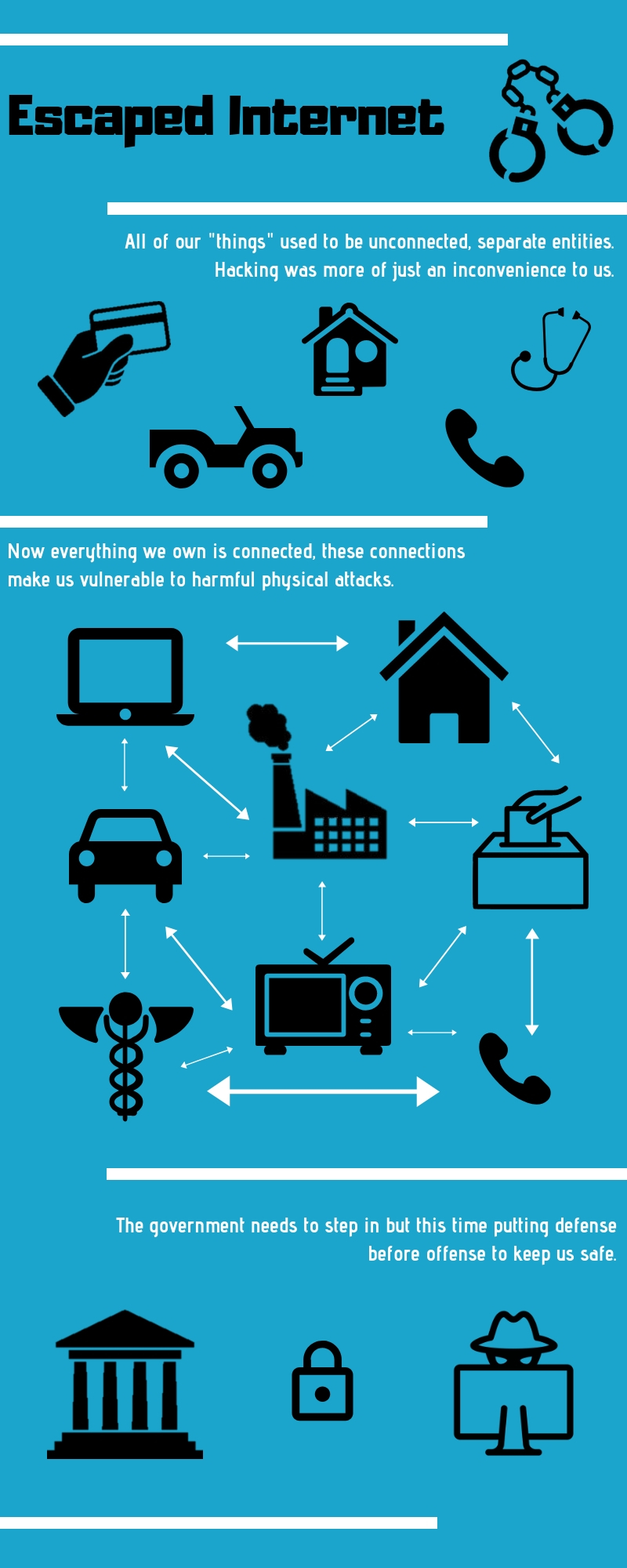In the short CBC podcast Bruce Schneier explains the risks we face in our hyper-connected world. Everything we own and everything in our society is now a computer with internet access including phones, cars, medical devices, power plants and thermostats. All of these connections make us vulnerable to harmful physical attacks.  The internet used to just be about data, when our data was stolen and abused it was more of an unfortunate inconvenience but now the internet has access to things that can actually harm us and this presents a real risk to our well-being. Schneier explains the only way for companies to improve the security on their products is for the government to step in and force them to. Without an order from the government the only thing these companies are concerned with is making a profit off ill-informed consumers who are not even thinking about the security risks of purchasing a new refrigerator.
The internet used to just be about data, when our data was stolen and abused it was more of an unfortunate inconvenience but now the internet has access to things that can actually harm us and this presents a real risk to our well-being. Schneier explains the only way for companies to improve the security on their products is for the government to step in and force them to. Without an order from the government the only thing these companies are concerned with is making a profit off ill-informed consumers who are not even thinking about the security risks of purchasing a new refrigerator.
I chose to use an infographic to summarize my thoughts on Bruce Schneier’s podcast and used Canva to create it. An infographic is exactly what it sounds like, an image such as a chart or diagram used to represent information in a fun and creative way. Canva is a graphic design website that uses a drag and drop format to create media design projects or graphics and offers users access to thousands of templates, fonts, graphics and pictures. I chose this method of reflection because the idea of graphically representing my ideas appealed to me. Sometimes pictures can say more than words which I believe was the case for me when creating this infographic. I liked using the Canva website because although it allowed me to be creative it also gave me suggestions so that the process of creating something from nothing wasn’t so intimidating.
While listening to this podcast I was immediately reminded of the time when my credit card numbers were stolen and used by someone to purchase gas along the California coast. I have never visited California so this could not possibly have been me, and that’s all I had to tell the bank to get them to reimburse me and cancel my credit card. It was shocking at first and I felt a little vulnerable but it turned out to be just a minor inconvenience in the grand scheme of things. I can’t imagine what it would be like to have someone hack into my car’s computer and demand bitcoin or be faced with the challenge of driving a car no longer controlled by me. That would be absolutely terrifying and potentially life threatening. Unfortunately, because we have created this hyper-connected world we are all vulnerable to these types of risks on a daily basis.
I’ve always held the belief that companies selling me products are not just concerned about how much money they are making off of me but also that they have made sure that my personal information will remain safe and that I would be able to confidently use their product without worrying of potential security threats. I assumed that when buying a car in the future I would not need to worry about how easily it can be hacked and potentially used as a weapon with me still in the driver’s seat or used as a place to hold me hostage while demanding bitcoin. That is why the points brought up by Bruce Schneier in this podcast were so shocking to me. After listening to the podcast and doing some more reading on the subject I know that the way I go about buying any sort of technology in the future will be forever changed. When Schneier was speaking about the dangers of our hyper-connected world it got me thinking about all the connections I have in my life between all of the technology I use on a daily basis. I think the biggest take away I got was to be my own advocate when it comes to the safety and security of my personal information because no one else is going to do it for me and if they do it will be much too late.
In the podcast Schneier pointed out that companies are most likely not going to start making their products secure out of the kindness of their hearts because that would cut into their profits and the government has been slow to step in and take a more defensive approach to protect us from these threats, therefore our safety and security is up to us. In this increasingly technical and connected world it’s important that we educate students about the risks that come along with all the technology they are being exposed to. Does their home really need to be connected to their phones? With the thermostat, lights, TV and security system accessed through an app we are essentially inviting strangers into our homes because of convenience. Instead of remembering to turn off the lights we can just do it from the car on our morning commute. Educating students about what is available to them in terms of technology as well as the risks that go along with it will allow them to think critically about the risks they are opening themselves up to. Hopefully safety and security of citizens in the technical world will soon become the government’s first priority but until it is, as a future educator I will make sure to give my students the tools they need to protect themselves.
educate students about the risks that come along with all the technology they are being exposed to. Does their home really need to be connected to their phones? With the thermostat, lights, TV and security system accessed through an app we are essentially inviting strangers into our homes because of convenience. Instead of remembering to turn off the lights we can just do it from the car on our morning commute. Educating students about what is available to them in terms of technology as well as the risks that go along with it will allow them to think critically about the risks they are opening themselves up to. Hopefully safety and security of citizens in the technical world will soon become the government’s first priority but until it is, as a future educator I will make sure to give my students the tools they need to protect themselves.
Please take a look at my infographic that summarizes my thoughts on Bruce Schneier’s podcast. Thanks for reading!
Christine

